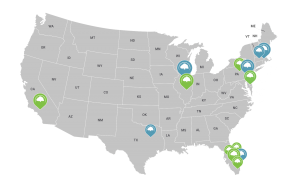Anxiety is a mental health condition that can manifest itself in various disorders, including generalized anxiety disorder (GAD), panic disorder, social anxiety disorder, and various phobia-related disorders. Anxiety, itself, refers to feelings of worry, fear, or tension. For some people, anxiety can also lead to panic attacks, which are episodes of distress marked by physical symptoms like rapid breathing, chest pain, and tightness. As you can imagine, this isn’t a pleasant experience. This is why we’re sharing how to identify anxiety triggers to prevent and properly manage symptoms.
“I Don't Know Why I Am Anxious”
While you may believe you’ve felt anxious for no reason, there’s almost always an underlying cause. The trigger may just be beyond your awareness. Especially if it’s something that you typically come across or deal with daily, identifying anxiety triggers can be especially tricky. If you constantly feel anxious without knowing why, then you might have generalized anxiety disorder (GAD).
GAD is a mental health condition of excessive worry about everyday issues and situations. GAD usually lasts longer than 6 months. Individuals with GAD may experience symptoms like worry, restlessness, fatigue, trouble concentrating, irritability, increased muscle tension, and trouble sleeping.
Other possible reasons you may feel anxious for “no reason” include:
- Anxiety is hereditary. If you have a close-blooded relative who has it, you’re more likely to develop it.
- According to one brain imaging study, people with free-floating anxiety tend to have denser neurons in certain regions of the brain than people who don’t. Increased functioning in areas of the brain associated with anxiety was found in participants, specifically in regions like the amygdala, anterior cingulate/medial prefrontal cortex, and superior temporal gyrus.
- Medical conditions like arthritis, asthma, COPD, and diabetes have also been linked to anxiety.
What Causes Random Spikes of Anxiety?
A sudden spike of anxiety can be caused by many things, from general situations such as the loss of a loved one or loss of employment to more specific situations like a sudden meeting at work with supervisors or coming across something triggering on social media. As previously mentioned, the main causes of anxiety may be more complex.
Keep in mind that experiencing anxiety every once in a while is normal, especially when there is an identifiable cause. However, if it begins to happen frequently or affects your ability to carry out your usual tasks, we recommend reaching out to a mental health professional for a clinical assessment. Bnayan’s mental health facilities offer these services to help clients determine whether they have a mental disorder, the extent of their symptoms, and the best course of action for treating them.
Additionally, learning how to identify anxiety triggers can help you pinpoint the things you need to avoid or learn to manage them. This can be especially helpful if you’re feeling anxious for no reason.
Tips on How to Find Anxiety Triggers
If you can identify what triggers anxiety, you can work to avoid and/or cope with them. You can also learn specific coping strategies to handle these triggers when they happen. Below are some tips for identifying your anxiety triggers:
- Take notes when you feel anxious: A great way to recognize any triggers is to make a note of them whenever you feel anxious. Jot down details about your surroundings, who you’re with, what you smell and hear, and even what you ate (if you’re eating). Over time, you’ll likely catch a pattern of things that are usually present or those you experienced that contributed to your anxiety.
- Do research on your diet: Diet and anxiety go hand-in-hand. Foods that make anxiety worse include processed meats, high-sugar foods, caffeine, and alcohol. Also, take note of when you’re eating these foods and how you feel. If you notice that your anxiety levels peak after having coffee, soda, or eating sugary foods, then simple adjustments in your diet can make a huge difference.
- Pay attention to how much you’re sleeping: Lack of sleep can greatly impact our mood and make us more likely to feel moody and anxious. Getting your 8 hours (or more) every night is crucial for maintaining a healthy balance both physically and mentally. If you find that you’re struggling to fall asleep or you tend to be up too late, you should try cutting off screen time at least 30 minutes before bedtime, reading in bed, and avoiding caffeine and sugar a few hours before your bedtime.
- Consider who you spend your time with: Let’s face it. Some people are just plain old anxiety-inducing. It’s okay to limit your time with certain individuals if you know being with them is going to bring up some unwanted anxiety. Consider if the relationship is toxic or if you need to find a new way to communicate with this individual. If it's something that they tend to say or do whenever you spend time together, consider expressing how you feel. They might not realize they're causing you anxiety.
- Consider what you’re watching and reading: With so much information available to us at the swipe of a finger, it’s understandable why some individuals are triggered by things they see on social media apps like Instagram and TikTok. The source of both good and bad news, the internet and television can expose us to things that can easily spike our anxiety. If you’ve been experiencing anxiety lately or you feel as if you’re anxiety is getting worse, consider the things you’re exposing your mind to. What are you watching or reading on social media or T.V. that may be exacerbating your symptoms?
Because this process can take time, the experts at our Florida rehabs for mental health share a checklist of anxiety triggers you can use as a base to help you get started:
- Alcohol
- Caffeine
- Conflict
- Financial problems
- Lack of sleep
- Life transitions
- Low self-esteem
- Medication
- Messy home
- Negative self-talk
- Self-neglect
- Social gatherings
- Stress
- Sugary foods
- Unbalanced diet
- Upcoming exams or meetings
- Work environment
In the end, all of the prep work you do will be most effective when it’s paired with professional care. If you believe you have an anxiety disorder or are struggling to cope with symptoms, the mental health specialists at our Sebring, Florida, rehab center can help.
How to Deal With Anxiety Triggers
Dealing with triggers of anxiety involves a structured approach that combines cognitive, behavioral, and lifestyle strategies. Here are practical steps to address and manage anxiety triggers:
- Identify triggers: Of course, the first step is knowing what triggers your anxiety. Pinpointing the things that contribute to your symptoms can teach you what to avoid.
- Cognitive behavioral therapy (CBT): CBT is an evidence-based therapeutic approach for anxiety that identifies and challenges irrational or negative thought patterns that contribute to symptoms. Mental health facilities such as our Sebring drug rehab offer CBT that helps individuals with mental health disorders like anxiety learn how to manage their symptoms.
- Breathing techniques: Learn and practice deep breathing exercises, such as diaphragmatic breathing. Controlled, slow, and deep breaths can help calm the body's stress response.
- Progressive muscle relaxation: This technique involves systematically tensing and relaxing muscle groups, which can reduce physical tension and anxiety.
- Exposure therapy: Gradual exposure to anxiety triggers can help desensitize your response. However, this should be done under the guidance of a therapist to ensure safety and effectiveness.
- Medication: For severe or persistent anxiety, medication prescribed by a healthcare provider may be considered. These can include selective serotonin reuptake inhibitors (SSRIs), benzodiazepines, or other anxiolytics.
- Lifestyle modifications: Make changes to your daily routine, including regular exercise, a balanced diet, adequate sleep, and reducing or eliminating caffeine and alcohol intake, which can exacerbate anxiety.
- Stress management techniques: Incorporate stress reduction methods like mindfulness meditation, yoga, or tai chi into your daily routine to manage overall stress levels.
- Self-care: Engage in activities you enjoy and that promote relaxation and well-being. This can include hobbies, spending time with loved ones, or taking time for yourself.
- Time management: Organize your daily schedule to reduce time pressures and deadlines, which can be significant anxiety triggers.
- Support network: Lean on your support system, including friends and family, and consider joining support groups or online communities for individuals dealing with anxiety.
- Mindfulness and grounding techniques: Practice mindfulness to stay present and grounded during anxiety-triggering situations. Techniques like the 5-4-3-2-1 grounding exercise can be helpful.
- Positive affirmations: Replace negative thoughts with positive affirmations to reframe your perspective on anxiety triggers.
- Journaling: Regularly journal your thoughts and feelings related to anxiety triggers. This can help track your progress and identify areas for improvement.
- Seek professional help: Consult with a mental health professional, such as a therapist or psychiatrist, for guidance and treatment tailored to your specific triggers and needs.
The effectiveness of these strategies may vary from person to person. A healthcare provider can help you develop a tailored anxiety management plan based on your specific triggers and symptoms. Additionally, if anxiety significantly impairs your daily functioning or quality of life, seek professional help.
Help for Anxiety at Banyan
If you believe you worry too much or suspect you have an anxiety disorder, it’s time to seek help. Despite it being one of the most common mental health disorders in the nation, identifying anxiety can be difficult because symptoms can become commonplace over time. You can begin recovery by reaching out to a mental health care provider, such as those at our Banyan rehab center.
Our Sebring, Florida, rehab center offers residential mental health care for individuals with anxiety. This care is also available to treat depression, schizophrenia, OCD, and other disorders. In addition, we provide care for those who have turned to drugs and alcohol to self-medicate and have developed an addiction as a result.









